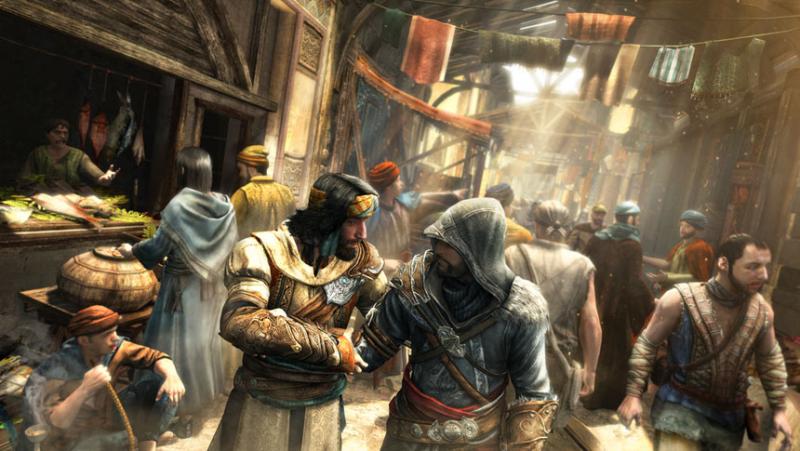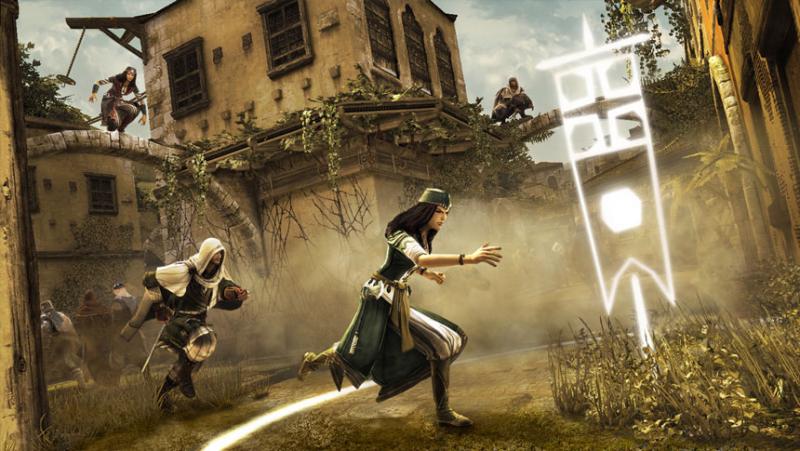Review: Assassin's Creed: Revelations
Ubisoft's Assassin's Creed: Revelations picks up right where the previous game left off, and plunges players back into the world of Desmond Miles and his memories of his assassin ancestors, Ezio and Altaïr, and their fight against the Knights Templar.
The game lives up to its "revelations" sub header, as it reveals plenty of new story for those who have followed the series' fiction, marking the end of Ezio's story, while still keeping things open for a sequel. The well-executed story, as well as improvements to mission design and gameplay mark Revelations as one of the better entries in the series, with only a few flaws holding it back.
Story:
Revelations' plot begins after Desmond suffers a mental breakdown from the events of Assassin's Creed: Brotherhood, and he is placed in a sort of stasis in the Animus, the device that lets him experience his ancestors' memories stored in his DNA. After speaking to the disembodied personality of a previous test-subject trapped in the virtual world, Desmond learns he must experience all the remaining memories of Ezio and Altaïr so the machine can sort out the different personalities and restore his sanity.
Thus begins a grand adventure in which the player, as Ezio, seeks out artifacts in Renaissance-era Europe to further relive Altaïr's memories from the Middle Ages in order to discover the true purpose of the Assassin organization. The events may seem a bit convoluted at first, but as the game progresses, things start to come together.
Most of the game is played as Ezio, with shorter segments devoted to Altaïr and optional ventures as Desmond. The primary location, Constantinople, is a vibrant and expertly-designed city that serves as the perfect backdrop to the game's events and provides a massive environment to explore.

While in the city, the player discovers it has its own set of political drama, and meets a wide range of characters, each written with a compelling personality fleshed out by excellent voice acting. The romance storyline with the character Sophia, for example, develops in a gradual and believable way as the two characters interact realistically against the chaotic background of the game's events.
Such interactions help Revelations avoid the awkwardness that made the cinematics of the previous games inconsistent in their quality.
Gameplay:
Revelations follows a very familiar formula for anyone who has played the past Assassin's Creed games, but the overall design has seen some significant improvements and additions.
Missions in both Ezio's and Altaïr's storylines have a wide variety of objectives that prevent the game from falling into repetitive cycles. The player moves between chases through crowded alleys, stealthy infiltrations of enemy strongholds, conventional assassinations, and many other types of actions that feel unique and dynamic.
Many of the missions also encourage exploration of the vast environments, which as has always been the case with Assassin's Creed games, is an experience all on its own. This is thanks to the free-running and smart-climbing systems that allow players to easily move about the complex architecture of the city.
There is just as much variety in the side-missions as well, as Ezio arrives in Constantinople recognized by the resident Assassin sect as a mentor, giving the player the role of a general expanding control over the city. This also brings back the micromanagement of city resources introduced in Assassin's Creed II, upgrading shops, expanding territory, and recruiting followers, but every such mission has a wide variety of possible scenarios, keeping things fresh.
Training the recruits that follow your commands in the city is also a compelling part of this, as they have their own set of expanded abilities to develop during missions.
The number of side missions and challenges can actually be somewhat overwhelming, but each has been designed with enough polish that they do not seem arbitrary or tacked-on.

The optional segments with Desmond focus on repairing his own memories in puzzle-platforming sequences that offer a bit of background into his earlier life. The abstract, geometric puzzles are somewhat simplistic and boring, but they offer an interesting diversion from the main story.
One new gameplay idea fails in its implementation, however. When the player captures territory from Templars in the city, after gaining prominence, the captured den will come under attack, requiring a defense in order to keep it.
This initiates a sort of tower-defense mini-game where waves of enemies march up a street while the player places archers and assassins in position to defend. The controls for this are clunky and the game usually results in waiting for the waves to finish after the player places enough units. Moreover, the slower play-style of these scenarios seem out of place alongside the other combat-oriented missions.
The combat itself, however, remains one of the strongest elements of the game, though players who did not like the fighting in the previous games will not find much different. Players still rely on a system of attacks, counters, grabs, and blocks, with a familiar set of weapons like swords, axes, and the iconic hidden blade.
New weapons, such as a hook blade, add some new spice to the combat and also come in handy during exploration, and crafting of different types of bombs add yet another dimension to fighting and evasion. Players may find themselves ignoring a few of these items in combat however, in favor of the more effective sword fighting system.
While fights can sometimes devolve into a repetitive exercise of counter attacking, the combat system is fluid enough to accommodate players who want to make use of the full set of moves. Combos let players dispatch enemies with satisfying moves and chain together kills in a fun and effective fashion.
The button layout has some significant changes, as primary weapons like a sword are separate from secondary weapons like bombs or throwing knives. This allows for quicker reactions to different situations, since the player has more immediately at their disposal, and combat can have a bit more variety.
Multiplayer:
The multiplayer introduced in Assassin's Creed: Brotherhood returns, with a few new improvements that help expand its offering.
A new deathmatch mode gives players an opportunity to track down targets without the benefit of a compass, making for some tense games of stalking and hunting. The "Artifact Assault" mode works as a game of capture the flag, and is much more fast-paced than the other modes.

The multiplayer is integrated into the larger plot of the Assassin's Creed world as well, as it features a story focusing on the Knights Templar, and leveling up the player's character unlocks more secrets about the organization.
Overall, it is a compelling and fun addition to the already solid singleplayer that will reward those who want more plot as well as competition.
Final Thoughts:
Assassin's Creed: Revelations makes a number of improvements and changes to the series' formula, but its core gameplay remains the same as previous installments. Its strengths lie in how its refines the best elements of the series, combat and exploration, and improves its weaknesses in the storytelling and gameplay variety. Some new design choices like the den-defense segments fall flat and hold back the overall package, but the end result is still one of the best games in the Assassin's Creed series.
Score: 9/10
Best way to find more great content from Neon Tommy?
Or join our email list below to enjoy the weekly Neon Tommy News Highlights.



